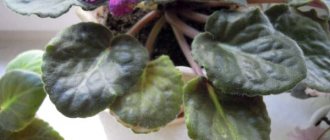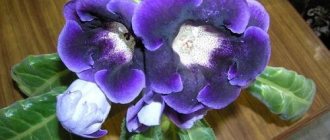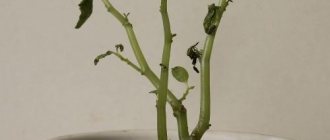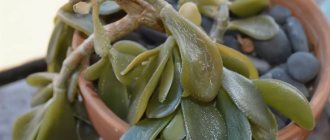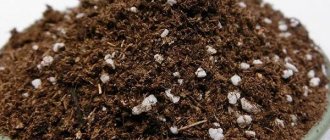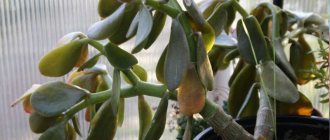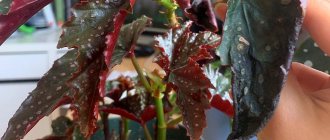Leaves turn yellow and dry out
It is a pity if large violet leaves begin to dry out, especially when they should not do so. But this is exactly the problem that flower growers face most often!
— Violet leaves turn yellow and wither if the conditions are not suitable for it, because each variety has its own characteristics;
— Leaves may turn yellow if they are constantly exposed to water when watering;
— Ring yellow spots appear in winter when the flowerpot is in a draft;
— The plant turns yellow, becomes stunted and lethargic due to root rot. Then urgent drying and replanting with fungicide treatment is needed;
— Wide yellow trails on the leaves are left by thrips when they eat away the pulp.
Photo: raiclimat.ru
Common causes of violets drying out
Let's look at the reasons why violet flowers dry out and fall off and why the foliage turns black.
Lots of sunshine
Saintpaulia is a heat-loving plant that grows naturally in the hot climate of Africa. The flower grows in the shade of trees, which provide protection from the sun's rays. When a violet on a windowsill is exposed to direct sunlight, the leaves and flowers begin to dry out and wither. Therefore, the window is shaded or the flower pot is moved to another place. But, in any case, bright lighting is required.
Brown spots on violet leaves
Household violets rarely suffer from fungus, but this happens much more often with outdoor flower beds. And the first symptoms may be rusty, brown or brown spots on the leaves.
— Large brown spots appear on delicate leaves from cold and drafts;
— The leaves turn brown when the violet lacks nutrients. Indeed, during flowering, it absorbs them twice as actively;
— Textured red spots appear when damaged by rust. She likes humid but fairly cool days. Sometimes orange bumps appear;
— Brown soft shoots and leaves are a sure sign of brown rot of the same name, which most often affects young plants;
— Brown spots on the leaves due to late blight dry out and spread almost before our eyes;
— The leaves begin to darken and rot from the stem and petiole if the violet suffers from fusarium. The disease affects the root system, and it is almost impossible to cure it;
— Chaotic brown streaks combined with a stop in development indicate an incurable bronze virus;
— The leaves darken at the edges when the violet soil is too wet and needs to be dried.
Photo: aa2aa.ru
Petunia leaf diseases: descriptions with photos, treatment
Treatment options
By changes in its appearance, the violet signals its poor condition. If the leaves begin to dry around the edges, then there is a lack of compliance with the rules for caring for these delicate flowers . To help the plant and prevent its death, it is necessary to take measures to improve agricultural technology as soon as possible:
- adjust the watering regime. The frequency of watering should be selected depending on the time of year, room temperature and the individual characteristics of each plant. The problem with individual selection can be solved by using pots with automatic watering or switching plants to wick watering;
- water with soft water. Hard tap water should be left to stand for at least 24 hours. Flower growers living outside the city can use rain or melt water for irrigation;
- monitor air humidity. As necessary, the air should be humidified by possible means;
- Fertilize regularly. Depending on the season and growth phase, violets require different nutrients, macro and microelements. It is necessary to systematically fertilize or transplant plants into a new nutrient substrate.
White coating on violet leaves
At first, the white coating may seem like a thick layer of dust. The leaves of the violet are textured in themselves, so at first it is not too visible whether there is a coating or cobwebs on them.
— An intense white coating is left by powdery mildew, one of the most common fungi on plants;
— A grayish coating on brown softened leaves is a symptom of gray rot or botrytis;
— Pale mucous plaque on hot summer days is a sign of vascular bacteriosis. It is urgent to establish ventilation and lower the air temperature;
—Large white flakes throughout the plant indicate the presence of mealybugs;
- A silvery coating that quickly darkens or turns red appears due to downy mildew.
Photo: sanpros.ru
Diseases of raspberry leaves: descriptions with photos, treatment
We answer why the leaves of violets dry out at the edges
The appearance of dry tips on the leaf blades of indoor violets is a fairly common occurrence. The reasons for such changes may lie in improper care, the presence of diseases or pests. It is necessary to inspect the violet as soon as possible and understand what led to the drying of the leaves .
The sooner the diagnosis is made, the sooner measures can be taken to save the plant. Delaying may lead to the fact that it will no longer be possible to save the flower.
Pale and light leaves
Most varieties of violets grow with beautiful decorative leaves, so it is quite easy to notice when they fade and fade. Find out the reason and quickly adjust the care - then the flower will recover on its own!
- Sucking insects draw out all the juices from the violet, and it fades and withers;
— Nematodes eat the root system, which is why the above-ground part grows weak, sluggish, pale and deformed.
Photo: domashniecvety.ru
Diseases of strawberry leaves: descriptions with photos, treatment
General advice on what to do if a violet withers and dries
- Remove damaged leaves immediately; they will not recover anyway, and the plant will have to spend a lot of energy maintaining their vital activity.
- If you find signs of disease, remove the violet away from other flowers, as there may be pests on it and your neighbors risk infecting them too.
- Regardless of the cause of the disease, it is better to transplant the flower into a new substrate.
- Violets are very sensitive to microclimate; it must be stable. Avoid room temperature changes, drafts, and stuffiness.
- Water only with purified warm water.
- Bathe your violets from time to time, this will support their immunity.
- In winter, heat-loving plants are especially vulnerable; monitor them carefully.
Even a very experienced florist will not be able to immediately tell you why the violet is drying up. You will have to carefully review every possible cause and change the conditions of care.
It is not always possible to save the plant. But even if things are bad, you can try to revive the cutting by cutting it at the root, removing most of the leaves and placing it in water so that it takes on new roots. Very often in such cases the violet begins a second life.
Is it possible to save a dried flower?
A very dangerous condition for violets is lack of moisture. A dried violet is difficult to revive ; if it is not completely gone, there is a chance.
In such a situation,
it is important to identify the living parts of the plant:
If changes in the condition of the flower are noticed in time and measures are taken, resuscitation may not be achieved. Sometimes the reason for the lack of the required amount of moisture is not forgetfulness, but planting in a new pot, using a new type of watering, or other changes in care in which the owner does not even notice that the plant is not receiving moisture.
Find out how to save and revive a violet
Regardless of the care taken and the number of individuals in the collection, there are times when violets die. Damage by pests and diseases or care errors can completely destroy an individual, and sometimes several at once.
If it is too late to take treatment measures, all that remains is to revive the dying violet . How to revive violets at home depends on the problem that is causing the plant to die, on the experience of the grower and the materials available.
Useful tips for preventing diseases in Saintpaulias
In order for Saintpaulias to develop and bloom well, it is necessary to create the correct conditions of maintenance and care:
- Periodically treat the plants under running water at a temperature of up to +40 ° C from a shower horn. At this moment, you should ensure that excess moisture does not get into the soil. Such prevention is reasonable at intervals of 2-3 months. Polyethylene is tied around the trunk of the plant and the flower pot so as not to wash away the soil. After this, the flower is poured out of the shower and left in the bathroom until the leaves are completely dry. Otherwise, white or brown spots may appear on them. Brown ones are caused by sunburn, white ones are caused by hypothermia.
- To combat diseases and insects, use a solution of garlic cloves. To do this, 3 cloves are kneaded and placed in 1 liter of water. Cover the contents with a lid and keep for 24 hours at room temperature. The resulting infusion is diluted with 5 liters of water and the soil and leaf plates of Saintpaulia are treated. After processing, the flowers are blotted to remove any remaining water.
- In difficult cases, it is necessary to use chemical methods to combat diseases and pests of violets. The most common remedy for combating fungal diseases is Fitosporin. To do this, 5 g of insecticide is soaked in 5 liters of water for 30 minutes. Having collected the resulting solution with a medical syringe, thoroughly moisten the soil in the pot. If the drug Fitosporin M is available, spray the plants by dissolving 10 g of powder in 1 glass of water.
- A weak solution of potassium permanganate is used to combat incipient diseases of fungal origin. When cultivating the land, you need to dilute 3 g of potassium permanganate in 5 liters of water and thoroughly pour in the resulting dark mixture.
- Before treating violets against insects, the leaves should be wiped with an alcohol solution to remove immobile specimens and the plaque formed by them.
- To combat ticks, thrips, and aphids, the drug Fitoverm is suitable, an ampoule of which is dissolved in 1 liter of water. If you have a pet shampoo containing permethrin, add 1 teaspoon to the solution. The violets are treated after 3 days, repeating the treatments 4 times.
- To destroy eggs and larvae of ticks, I use the drug Nissoran, using 1 g of product per 1 liter of water. The soil and plants where the offspring are located are sprayed, which die within 1-2 weeks.
The edges of violet leaves are drying out
Found a mistake? Report it: 1) Select the error with the mouse 2) Press CTRL+Enter. Read more.
I have a problem, I read about all the diseases, but I can’t diagnose it myself. Help me please!
I bought 13 babies, gradually spots began to appear on all of them (see photo)
Everything is on wick watering (a mixture in my opinion: peat, vermiculite, perlite - this is by eye), after the purchase I did not replant it, watered with distilled water with Kemira combi, north side, window sill.
This is the initial stage on newly purchased violets; the young leaves are affected first.
I treated it with phytoverm, the result was deplorable, in my opinion it got even worse!
Topaz didn’t give any improvement either!
- Login or register to post comments
- print version
Violet leaves dry around the edges
Go to our new website https://fialki.of.by/ - click on the link. All new varieties, special offers and prices only on the new website!
new varieties of STREPTOCARPUS – click on the link
new varieties of violets - click on the link
Lately I have been very often faced with the problem of violet lovers abusing chemicals to treat plants against mites, thrips and other infections. Something is slightly wrong - they immediately treat their plants with quite toxic agents. Without even understanding the nature of the disease. Thus, poisoning not only yourself but also your loved ones.
Before you fly to the nearest flower shop for fitoverm, agravertine or neoron, you need to think about how this or that disease appeared on your plants. Ticks, thrips, aphids, scale insects, etc. can only enter your home with a purchased baby, a bouquet of flowers, through a window (except in winter). There are no other sources of infection. Therefore, if you did not bring home all these sources of infection, you have mosquito nets on the windows or, even better, snow outside the window - this is not a tick (thrips, aphids, etc.).
So, if you suspect you have a tick,
those. deformed leaves, curved and small, appear in the center of the rosette; on shortened petioles, you should carefully examine the center of the rosette with a magnifying glass to identify the mite itself. The tick really loves thickening, and in these places it would go through 2 reproduction cycles even in 2 weeks. And its quantity would already be enormous. You would have noticed. If the violet in the thicket is not infected, then it is 99.9% not a mite. Most likely this happened due to violations of agricultural technology. Complete drying, death of the root, plus heat, puts stress on the plant. The hormones abscisic acid and ethylene are produced. Ethylene blocks the development of the apical meristem, and the growth point is inhibited. In combination with abscisic acid, such a cocktail can give exactly the same picture as with tick oppression. After all, the picture of small, hard leaves when attacked by a mite is given not only by the mite infestation itself, but also by the hormones that are produced under such stress. Or drying out, death of the root, then watering, souring, a drop in immunity, the center of the socket becoming stuck on which a secondary infection sticks. It gives a picture of pinpoint and crooked lesions on young leaves.
If spots appear on the violet leaves, the leaves dry out around the edges
.
Most likely this is due to a lack of osmotic pressure created by the roots. Those. the roots do not “pump” water enough. The pressure is only sufficient for young leaves that have a small evaporation surface. Leaves with a large evaporation surface evaporate more water than they receive. Hence the withering.
Sometimes overfed leaves grown with a lack of light can wither - they have a loose structure and look like burdocks, and have a large surface area. (add the amount of light, not the length of light, do not fertilize, tear off old large leaves, i.e. reduce the evaporation surface.).
When part of the roots, especially root hairs, die off due to severe drying, and it is with the help of horse hairs that the roots receive most of the water and nutrition. (you just need to normalize watering)
When the substrate becomes waterlogged and sour, and pathogenic microflora develops. (a transfer is needed here).
If there is a lack of oxygen to the roots, the roots must breathe. (replace alumina with a loose substrate).
The leaves just age - this is a normal process. (tear off old leaves).
If you find lightened areas of irregular shape on the leaves,
sometimes similar to a marble pattern - a high probability of sunburn, especially after spraying the plant. These spots may also be associated with temperature changes when opening the window.
You dug up a violet and found thickened roots
which are easily destroyed, or a thickened stem shaped like a carrot - NEMATODE? Maybe. But exactly the same formations are also characteristic of plants with wick watering.
Over-drying, over-watering. If the plant has no turgor,
this means that evaporation by the leaves exceeds the pumping of water by the roots, or high osmotic pressure is aimed at extracting water from the plant into the substrate.
1) Over-salted substrate, i.e. there is a law when the concentration of salts always tends to balance, and if the concentration of salts in the substrate greatly exceeds the concentration of salts in the plant itself, then the osmotic pressure tends to extract water from the plant into the substrate. And it is more difficult for the roots to overcome this pressure, i.e. the roots cannot pump up water.
2) there is no root, it is poorly developed, the root hairs are poorly developed or destroyed due to severe drying and it has rotted, etc.
3) the substrate is very dry
Superficial mechanical damage
Long days, overfertilization, violation of agricultural practices
Deepening of the growth point - the appearance of rust
Violet withers after transplantation
Often after resuscitation, especially if the Saintpaulia had to simply be transplanted, there may be no improvement or the flower’s condition may even begin to deteriorate . These processes are manifested by general lethargy, loss of turgor, and a change in the shade of the leaves. In this case, how to save a violet that is withering?
It is important not to panic and assess the condition of the individual , because it may simply be a slow improvement after an illness, or it may be an incorrect diagnosis and/or incorrect treatment.
If the plant is simply slowly recovering or there is no improvement at all, you should think about changing the resuscitation method or just watch and wait . For example, if the rooting of the top is carried out in the ground, it is worth doing this in water. If Saintpaulia becomes worse, it is necessary to urgently examine all parts of the flower for any undetected problems and take measures to improve the condition.
If the violet withers after transplantation, check whether your actions are correct.
Wilting can also begin due to improper care. If the reanimated plant is over-watered, then even if this was not the problem initially, the excess moisture will play a negative role in the treatment.
If a violet has dried up, what should you do?
One of the most common problems when growing violets is premature drying of buds and flowers . This is due to errors in care or unsuitable environment.
By establishing proper care and correcting errors in plant maintenance, the problem of drying buds will be solved.
The main condition for violet health is proper care.
There are main reasons why a violet has dried up, and below we will look at them carefully.
Causes
Air humidity
Perhaps one of the most important reasons why violet flowers and buds dry is low indoor humidity. Dry indoor air has a detrimental effect not only on flowering, but also on the growth of Saintpaulia in general.
The problem of low humidity becomes especially urgent during the heating season , when due to the heating of the radiators, the humidity drops to 30%.
Many people mistakenly believe that it is enough to spray the plant with water from a spray bottle twice a day and that will be enough. The humidity will not rise significantly, and the delicate violet leaves may rot.
Content temperature
High temperatures do not promote normal plant development. The optimal ambient temperature for growing indoor Saintpaulia is 20-24 degrees Celsius.
An increase in temperature for a short period of time is not dangerous for Saintpaulia. Temperatures above 29 degrees Celsius are dangerous. High temperatures always make the air dryer.
Air temperature significantly affects violets.
Any increase in ambient temperature has a detrimental effect on flowering. It can be reduced by increasing the humidity in the room or increasing the frequency of ventilation.
Lack of lighting
Due to lack of lighting, the plant does not have enough strength to bloom , so the buds may wither without opening. There are other signs of lack of lighting:
This problem often occurs in winter, when daylight hours decrease and the number of cloudy days increases. If the plant is located far from a window or light source.
Additional artificial lighting or placing a pot of Saintpaulia in a brighter place will help correct the situation
If the plant is initially grown under artificial lighting, it is necessary to reduce the distance between the plant and the device or replace the lamps with more powerful ones.
High soil acidity
The optimal soil acidity pH for violets is 6.5. If you deviate from this indicator, it is difficult for the plant to absorb nutrients, it stops developing due to their lack:
Changes in soil acidity can occur if the soil is not selected correctly. It is worth doing a complete transplant of the plant into a new suitable soil.
Excess nitrogen in the soil
Excess nitrogen promotes the growth of green mass, but flowering will be absent. To correct the situation, it is necessary to replace the complex fertilizer with another one, with a lower nitrogen content, or replant the plant in new soil.
Violet overfed with nitrogen.
Drafts and cold air flows during ventilation
Indoor Saintpaulias are very afraid of cold drafts. In this case, the plant will not only not bloom, but may also die completely.
Signs of this will be white and brown veins on the leaves . To avoid this, you need to remove the pot with the plant from the window during ventilation.
Treatment options
Having found out the causes of the disease, you should decide what to do if the violet dries up. To correct the situation of premature drying of the buds, to restore the lush flowering of the plant, you must do the following:
If the violet dries out for no apparent reason, replanting can help.
If the problem why the buds have dried out is due to improper conditions, then you can save the remaining buds after adjusting the conditions and feeding the plants with fertilizer containing phosphorus.
In other cases, it is better to remove all the flowers and buds yourself so that the plant does not become even more depleted . It is better to be patient, correct all problems and wait for healthy flowering.
Place in water
This method is suitable for cases where the greenhouse did not help the plant. You need to tear off a few of the lower leaves of the violet, place it in a container with water, and cover with a bag. This method will help grow the root system, the results will appear in about a month. Then you can start planting the plant. After placing the violet in a pot of soil, place it in a pan of water and cover it again with a bag to help the flower take root.
Then, over the course of a couple of weeks, you need to accustom the violet to less humid air every day. How to do it? To do this, you can open the bag once a day to introduce new air to the plant. After about 14 days, the polyethylene can be removed.
Save the best leaf
This method can help if previous methods did not work and the flower continues to die. You need to carefully inspect the plant and choose the healthiest and densest leaf. Cut it off and place it in a glass of settled water. When the roots of the leaf grow a couple of centimeters, it will be possible to plant it in loose soil to a depth of 2-3 cm.
Using the methods listed above, you can save your favorite violet, even if it seems to you that the situation is already hopeless. The most important thing is not to forget about the basic rules for caring for this flower: store the pot in a warm place, water it 1-2 times a week through a tray (so that the plant does not rot), remove dry leaves and sometimes feed it.
